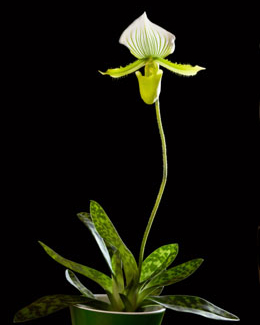Orchids maintained indoors add a lively touch to the interior décor. Successful growing of orchids as indoor plants is all about offering an ideal growing environment that imitates the natural habitat of these tropical epiphytes.

Orchids are undoubtedly some of the most adorable flowering plants known to us. But, planting them is considered a difficult project for home gardeners. And for those, who have less space for outdoor gardening, growing orchids as houseplants is nothing less than a challenge. But, the fact is, you can grow orchids indoors and enjoy the vibrant colored, lovely blooms with minimal effort. All you need is a bit of patience in growing and caring for these exotic plants.
Tips for Growing Orchids Indoors
So, what is the secret of growing orchids as houseplants? For successful maintenance of orchids, understand the essential growth requirements for these epiphytic plants. Believe me, you will find the tips for caring orchids very easy after learning the basic growth factors. Most of the orchid species are originated in the tropics, and require warm temperature, moderate sunlight, high humidity, moist and fertile soil for optimal growth.
With the development of hardy orchid hybrids by cross breeding, growing orchids in the indoor environment has become a lot easier that it was before. A thumb rule for maintaining healthy orchids is choosing the right cultivars. In the nursery center, you will get potting media, pots and tools, especially designed for growing orchids.
Select Orchid Variety
These flowering plants come in varied colors, shapes and sizes. But, do not choose cultivars just for the sake of their appearance or color. In short, you need to have a brief idea about the care level for the hybrids, and then decide accordingly. Common varieties opted for indoor gardening are moth orchid (Phalaenopsis), lady's slippers (Paphiopedilum) and cattleya orchids. At the time of purchasing, see to it that the young plant is healthy without discolored patches on the foliage and stem.
Potting Orchid Plant
As aforementioned, orchids are adapted in the tree trunks as epiphytes. So, keeping the roots fairly dry by planting in a porous medium is an absolute necessity. You can purchase a mixture of mulch and wood, specially prepared for growing orchids and alike tropical plants. Another consideration is the pot size, which need not be very large. The only requirement is, the pot should be able to support the delicate roots of orchids. You can purchase a small container, suitable for the size of your orchid plant.
Bright Filtered Light
Providing natural sunlight is a key tip to ensure timely flowering of orchids, which are grown indoors. You can place them near to an east or west facing window, where orchids get filtered sunlight for maximum time. If they are exposed to scorching sun, place them at some distance away from the window. And for indoor orchids that receive less light than required, installing a plant light is a practical solution. You can take suggestions from a horticulturist about artificial light source for orchids.
Water Orchid Plants
Tips for caring orchids involve watering them whenever the potting medium dries out. These exotic flowering plants are very sensitive to very less water or excess water. Hoping that you have grown orchids in a potting medium with no drainage problems, water them sparingly after every few days. A simple way is to check moisture level in the top soil layer. If it is wet, wait for 1 - 2 days, and water them. Over watering orchids will damage the roots and kill them.
Maintain High Humidity
As expected, orchids thrive in the high humidity conditions of the tropics. So, maintaining optimal humidity is another aspect when you want to grow orchids indoors. This can be achieved by using a room humidifier for some hours during the day. A simple alternative to switching on the humidifier is putting a water-filled tray below the orchid pot. Put some gravel in the tray, and refill water whenever required. This way, you can maintain a natural growing environment for orchids.
Fertilizing Indoor Orchids
For growing healthy orchids indoors, you need to apply orchid fertilizer (19-31-17) at regular intervals. In the active growing season, supplement them with a half strength orchid fertilizer or tropical plant food (20-20-20) once in a month. Also, feeding indoor orchid plants is a must to ensure that they develop maximum flowers. During the inactive growth season (winter months), avoid fertilizing orchids.
Inducing these tropical epiphytes to bloom calls for specific care level, but the aesthetic value of these flowers is unmatchable to others. Follow the above care guidelines for growing orchids indoors, and appreciate the beauty of delicate blooms in flowering season. Also, orchid blooms have a long shelf life, and they will continue to brighten up the room for many days to come.






 Orchids are undoubtedly some of the most adorable flowering plants known to us. But, planting them is considered a difficult project for home gardeners. And for those, who have less space for outdoor gardening, growing orchids as houseplants is nothing less than a challenge. But, the fact is, you can grow orchids indoors and enjoy the vibrant colored, lovely blooms with minimal effort. All you need is a bit of patience in growing and caring for these exotic plants.
Orchids are undoubtedly some of the most adorable flowering plants known to us. But, planting them is considered a difficult project for home gardeners. And for those, who have less space for outdoor gardening, growing orchids as houseplants is nothing less than a challenge. But, the fact is, you can grow orchids indoors and enjoy the vibrant colored, lovely blooms with minimal effort. All you need is a bit of patience in growing and caring for these exotic plants.